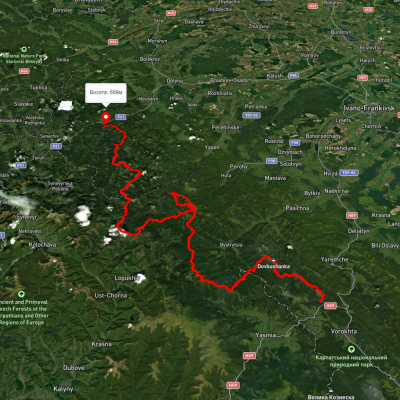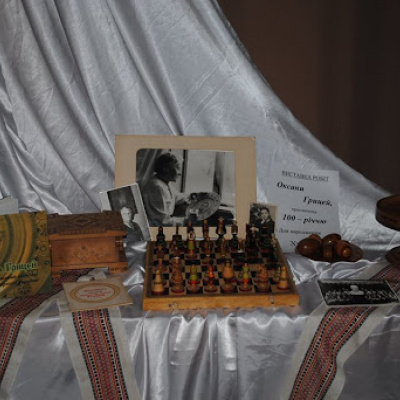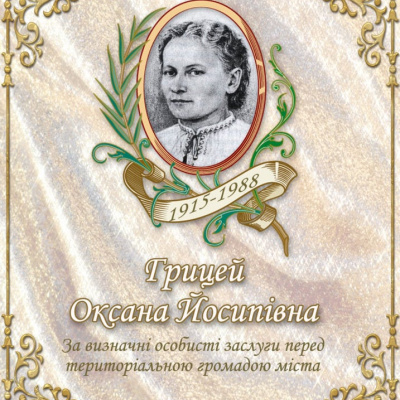Oksana Hrytsiy Museum, Dolyna
Oksana Wynnyk-Hrytsii (11.05.1915 - 13.08.1988) belongs to the glorious galaxy of talented people of the Dolyna region who, through tireless work and the amazing strength of their spirit, change this world for the better. Their names shine as bright stars in the sky of Ukrainian and often world culture, and will forever remain in the grateful memory of their descendants.
In addition, Oksana Hrytsii is an active participant in the national liberation struggle, a public figure and a teacher. God gave Oksana not only a great talent, but also a difficult thorny road with so many trials that would last for several lifetimes. But with God's help, she not only overcame all the difficulties, but also achieved great success and gained wide recognition for her talent. A gifted artist, Honored Master of Folk Art, member of the Union of Artists of Ukraine, Oksana Hrytsii is an unsurpassed portrait painter and an artist of a unique genre - artistic wood burning.
Oksana was born on May 11, 1915, in the picturesque outskirts of the town of Dolyna, Stanislav region, in the family of a court clerk, Yosyp Vynnyk. It was her father, an educated and intelligent man, who passed on to his daughter a love of books, a curiosity to learn about the world, a sense of patriotism and love for his people. While studying at Dolyna Elementary School and later at the gymnasium, the girl painted portraits of her teachers and friends, read a lot, and embroidered beautifully.
A striking event in the formation of Oksana's worldview was the arrival of the famous Lviv artists Pavlo Kovzhun and Mykhailo Osinchuk to Dolyna. In 1931, they were invited by the community of Dolyna to paint the Church of the Nativity of the Blessed Virgin Mary. This is how the church looked in 1906 after it was consecrated by Metropolitan Andrey Sheptytsky.
Pavlo Kovzhun, a graduate of the Kyiv Art School and a student of the Ukrainian Academy of Arts, gave young Oksana her first professional drawing lessons and encouraged her to continue her studies after examining the talented girl's works. Pavlo Kovzhun told the young people about the beauty of Rome, the spiritual and material treasury of the Catholic world, and the significant figure and mission of Metropolitan Andrey Sheptytsky. After hearing these stories, young Oksana studied art even harder, dreaming of a trip to Italy. But in addition to her desire to reach artistic heights, she lived in faith and hope of gaining an independent and sovereign Ukrainian state. She became an active participant in the youth underground movement, joining the ranks of the organization of Ukrainian nationalists, which at that time operated in the Valley under the leadership of Volodymyr Horbovyi, a doctor of law.
For distributing the OUN magazine Surma and political leaflets in 1936-1937, Oksana Vynnyk was placed under political arrest in Zolochiv prison, not even being able to attend the funeral of her father, Yosyp Vynnyk, and her brother, Marian Vynnyk, who died tragically. Her time in Zolochiv prison was a time when Oksana's social and political maturity was formed. In prison, she establishes contacts with the leaders of the regional branches of the OUN and with members of the resistance movement, who give her guidance for further work after her release from arrest.
Since 1938, she has lived in Lviv, where she has been involved in the city's artistic and political life. In the summer, she successfully passes the entrance exams to the Institute of Plastic Arts in Lviv. The works of the talented Oksana Vynnyk are admired by Lviv artists, including Mykhailo Moroz, a painter, graduate of the Oleksa Novakivskyi Art School in Lviv, and graduate of the Academy of Arts and Crafts in Paris. Being an ardent supporter of talented young people and the official portrait painter of Metropolitan Andrey III-Eptytsky, Mykhailo Moroz presented Oksana Vynnyk's works to him. The bishop praised the young girl's talent and offered her a scholarship to continue her studies in Italy.
Happiness for the realization of her most cherished dream was so close. However, the war of 1939 forever cut off all bright hopes and expectations. In order to avoid persecution and arrests carried out by the Bolshevik regime against the leading Ukrainian youth, Oksana left for Krakow on the orders of the OUN leadership, where she was trained in clandestine work in the underground and in the preparation of women's reconnaissance brigades in the enemy's rear or surroundings. At the OUN student center in Krakow, she met the talented sculptor Mykhailo Chereshnevsky, a native of Lemkivshchyna, who, after graduating from the school of woodworking in Kolomyia, completed his studies at the Krakow Institute of Plastic Arts. He was also a member of the Ukrainian art group Zarevo under the patronage of Bohdan Lepkyi.
In Krakow, Oksana worked both as an artist and as an underground political activist, serving as a special courier for the OUN leadership. Actually, on the instructions of the leadership, Oksana and Mykhailo came to Bolekhiv to engage in underground activities. Under the guise of an artistic woodcarving workshop, they created a cultural and educational center for young people.
Despite the harsh time, love sparks in young hot hearts. The young couple, who got married in the Bolekhiv church on March 28, 1942, were exemplary for everyone. Soon they rejoiced in the birth of their son Sviatoslav. However, during the war years, their happiness was short-lived: in 1943, Mykhailo and Oksana suffered the loss of their son.
During the difficult years of the German occupation, combining creative work, household and family responsibilities, and active underground activities required great effort. The German occupation authorities forbade any political activity, but did not deny cultural, educational, and economic activities. Mykhailo organized an underground weapons repair shop in the village of Tserkivni, and was an editor and author of leaflets on anti-fascist and anti-Soviet topics.
Oksana was a member of the women's committee for the protection and care of orphans. They taught children from the whole neighborhood carpentry, woodcarving, and drawing. Oksana and Mykhailo performed all their duties with great responsibility. To this day, there are still people alive whom Oksana and Mykhailo saved from starvation, death, and forced deportation to Germany.
But, unfortunately, they were destined to be together for a very short time... In the spring of 1944, the couple was forced to leave for Lemkivshchyna to visit M. Chereshnevsky's family. In June, their daughter Zvenyslava was born. However, the joy of the young couple was again overshadowed by the hand of war - in the fall Mykhailo was mobilized into the army, and fate separated them forever.
After terrible wanderings and severe trials of fate, Mykhailo ended up across the ocean in the United States, where he gained well-deserved fame as a recognized sculptor and master of artistic woodcarving through his inspired work and the power of his talent. The sculptures of the Mother of God, which he created in gratitude for the fact that the Virgin saved his life, are marked by originality and elegance.
Mykhailo Chereshnevsky lived in New York until the end of his life, but his soul was always with Ukraine, and he dedicated all his works to it... This is a monument to the Heroes of Ukraine - Symon Petliura, Yevhen Konovalets, Taras Chuprynka, and Stepan Bandera; he also created many other monuments to prominent figures of Ukraine. The monuments to Lesya Ukrainka erected in Toronto and Cleveland can also be called the pinnacle of his skill.
The ensemble of the Church of St. John the Baptist in the American city of Hunter is also unsurpassed as an example of exquisite folk wooden architecture of the Carpathian region, decorated with a carved iconostasis and other elements of artistic woodcarving.
After being separated from Mykhailo Chereshniovskyi, Oksana was unable to stay in the Lemkivshchyna region. Extremely difficult frontline conditions (the Bolsheviks burned down the village), a stranger, and her daughter's illness forced Oksana to return to her native Dolyna and live here for the rest of her life. In December 1944, Oksana's new life began - cruel, hungry, cold, scary, and responsible. A looted home, a sick mother and a small child in her arms were just some of the problems she had to overcome.
Zvenyslav's daughter needed surgery and treatment by highly qualified doctors. But there was no means of subsistence, and there were constant summonses for interrogations to the NKVD. Miraculously, she managed to avoid arrest and deportation to Siberia. But God did not allow Oksana to fall into despair. A kind and sincere man, Julian Hrytsei, gave her a helping hand, and she joined her fate with him in 1948. Together, it was easier to overcome difficulties and heal emotional wounds. The birth of her son Stepan in 1949, although it added to her daily routine, filled her heart with the belief that the worst was over.
As the children grew up, Oksana's heart grew to create, to realize her bright, God-given talent. She paints her beloved children, her mother, nature... Her husband Julian Hrytsei was a highly professional carpenter. According to Oksana's designs, he made the first carpentry products (boxes, plates), and Oksana decorated them using the burning technique. She was one of the first in Prykarpattia to use new tools - electric pysanky, which her husband Julian constantly improved so that she could regulate the heating power.
At the same time, she did not stop working for the OUN. Oksana Hrytsii was so skillful at fulfilling the leaders' orders that the enemies did not even realize that the artist was engaged in underground activities. She supported financially and morally the families of repressed OUN members and UPA soldiers. With great perseverance and love, Oksana plunged into the whirlpool of artistic creativity. Already in 1951, wooden boxes decorated with the burning technique were exhibited in Lviv, and in 1952-1953, a series of portraits of Taras Shevchenko, L. Ukrainka, Ivan Franko, and B. Khmelnytsky were created.
From Lviv exhibitions, all the exhibits were taken to the Republican exhibition in Kyiv. In 1953, he joined the Stanislav Cooperative Society of Artists. Every year, the works are exhibited at regional and republican exhibitions, and orders are received. Thus, by order of the museums of Kamianka, Kirovohrad region, he made portraits: Pushkin and Tchaikovsky.
For the Stanislav Museum of Local Lore - portraits of Bohdan Khmelnytsky and Ivan Bohun. In Lviv and Moscow, portraits of Leo Tolstoy and Lesya Ukrainka were exhibited with great success. Three portraits (at different ages) of Ivan Franko were made for the Ivan Franko Museum in Lviv. Portraits of Lesya Ukrainka and Ivan Franko were purchased by the Ministry of Culture of Ukraine for the Canadian Museum in Toronto.
A great talent was recognized! In Kyiv, at one of the republican exhibitions of decorative and applied arts, a professor at the Kyiv Art Institute, a famous graphic artist Vasyl Kasiyan, stopped in front of O. Hrytsiy's works and exclaimed: "It's a miracle, who is the author of these works? This is an incomparable miracle!"
In addition to portraits, Oksana Hrytsii's works of decorative and applied art occupy a significant place in her oeuvre. Decorative boxes, address books, albums, sets of inscriptions decorated with the technique of burning, coloring, carving, bead inlay...
The artist also perfectly mastered the technique of oil painting, drawing, and the refined decor of compositional construction and finishing ornamentation.
The artist created an interesting thing unique in its design - Ukrainian chess. Her pawns appear in a row of fir trees, the king is a Hutsul, the queen is a Hutsul woman in national folk costumes. The set also included an original chess table and two chairs. This work was repeatedly exhibited at exhibitions in Lviv and Kyiv, and in 1960 it was acquired by the Museum of the Kyiv-Pechersk Lavra.
A constant source of inspiration for Oksana Hrytsii was Ukrainian folk art: embroidery, weaving, Easter eggs, carving and inlay. Oksana Hrytsii penetrates deeply into the roots of the centuries-old development of folk art, studying and analyzing them in detail.
In July 1970, Oksana Hrytsii became a member of the Union of Artists of Ukraine, and in December 1980 she received the honorary title of Honored Master of Folk Art of Ukraine. Her works were published in magazines, literary and political journals of Ukraine. Prominent contemporaries such as the poet Olha Strelets, the writer Roman Fedoriv, the art critic Oleksii Solomchenko, and the writer Roman Horak covered the pages of the artist's life and work and popularized her name.
Olha Strilets wrote a poem about O. Hrytsia and an essay "The Creator of the Beautiful", which was published as a separate book in 1961.
Oksana Hrytsii passed on her boundless treasury of folk art to the younger generation. In the 50s and 60s, she worked at the Dolyna District House of Pioneers as a leader of art and embroidery clubs. She not only taught children to draw, carve, and embroider, but above all, she taught them to love Ukraine, to be proud of its history and culture, to preserve and multiply its spiritual and cultural heritage.
Oksana Yosypivna herself created the history of her native land and was a shining example for the younger generation of how to live in order to survive and overcome all the difficulties that fate has in store for them. She took an active part in the formation and creation of music and art schools in Dolyna.
Communicating with many educated and influential people in Lviv and Ivano-Frankivsk, she emphasized that she really wanted to see her native Dolyna become a cultural center. Back in the 60s, she raised the issue of creating an art and history museum of Dolyna with the local authorities and the Ministry of Culture, collected samples of embroidery, conducted ethnographic research, and dreamed of creating an art and culture center.
She was also a very kind, loving mother to her daughter Zvenyslava and son Stepan, to whom she passed on her boundless love for her homeland, hard work, and her desire for creativity and constant self-improvement. The son chose the artistic path - he graduated from the Kosiv School of Applied Arts, the Lviv Institute of Decorative and Applied Arts and worked creatively as an artist for many years. Using the technique of artistic leather processing, he created interesting compositions on Cossack themes, decorated interiors, and used unique combinations of techniques and materials. Combining wood and metal, he created a series of bas-relief portraits of figures of the historical past and present, combining wood and ceramics, he made original compositions for interior decoration.
He created a memorial sign to the victims of Nazism, which was installed in Ivano-Frankivsk on the building where the Gestapo was located during World War II. The artist always left a piece of his heart in his works, expressed his understanding of the eternal truths of beauty. Since 2002, he has been a member of the National Union of Artists of Ukraine. His works presented the art of Prykarpattia in Kyiv, Moscow, and participated in regional, national and international art exhibitions. Stepan Hrytsii's works are decorated in private collections of art lovers in Canada, the USA, Australia, France, Germany, and Poland. The artist's latest sculptural works are a bas-relief and a memorial plaque to Myroslav Antonovych, the founder of the Dutch Choir, in the Dolyna Children's Music School.
Oksana Yosypivna was proud of her children, sincerely rejoicing in their successes and achievements. As a mother, she took care of the young artists, supporting them with kind words and wise advice. Unfortunately, on August 13, 1988, the heart of the talented artist stopped. But the high light of her loving sincere soul, the bright sun of her talent will always shine on us so that we do not get lost in the darkness of indifference and despondency, hatred and evil. She, like Lesya Ukrainka, will always be an example of unbreakable spirit and boundless love for Ukraine.
Oksana Hrytsiy's artistic heritage is preserved in many museums in Ukraine, Cuba, Canada, the United States, Poland, India, Germany, and in private collections in Ukraine. Such is the wide geography of our compatriot's fame. A memorial plaque created by the artist's son, Stepan Hrytsii, was unveiled on the house where the artist lived. Together with his wife, Mariana Stakhmych-Hrytsii, Stepan opened a room-museum in his home, an art exhibition of the artist's works, and in 2006 they published a wonderful book-album "Oksana Hrytsii - Honored Master of Folk Art of Ukraine".
A street in Dolyna was named after Oksana Hrytsii. Students and teachers from Dolyna and the district, art lovers and artists from Ukraine and around the world often came to the Hrytsii family's hospitable home for excursions. Unfortunately, the artist's son, Stepan, was also taken to the beyond by inexorable death. But the bright memory of these talented, kind and sincere people will always live in our hearts.
Accommodation around Oksana Hrytsiy Museum, Dolyna:
Які маршрути проходять повз Oksana Hrytsiy Museum, Dolyna?
Пропонуємо пройти такі туристичні (пішохідні) маршрути через/біля Oksana Hrytsiy Museum, Dolyna: Маршрут на г. Щавна, На Горган Ілемський, с. Мислівка – г. Горган-Ілемський – с. Мислівка, с. Мислівка, через хр. Аршиця, г. Молода, г. Яйко-Ілемське до с. Мислівка, с. Татарів, через г. Синяк, г. Довбушанка, г. Чорна Клева, г. Братківська, г. Сивуля, г. Кінець Горгану, г. Попадя, г. Грофа до с. Мислівка, с. Мислівка, через г. Яйко Ілемське, г. Горган Ілемський до с. Мислівка

Маршрут на г. Щавна

На Горган Ілемський
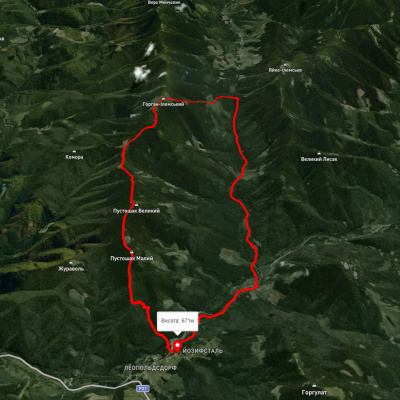
с. Мислівка – г. Горган-Ілемський – с. Мислівка
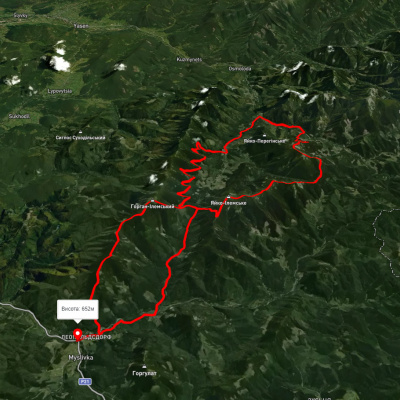
с. Мислівка, через хр. Аршиця, г. Молода, г. Яйко-Ілемське до с. Мислівка
